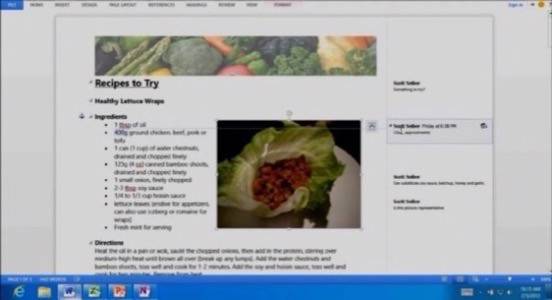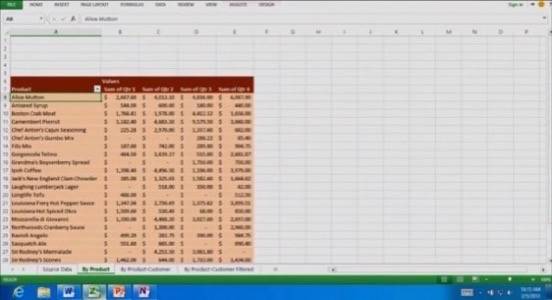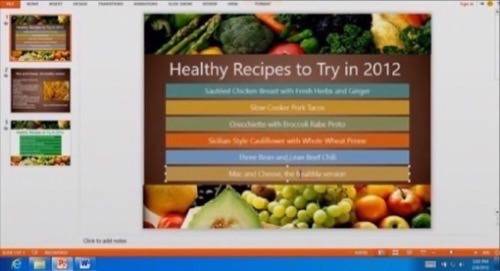As part of a carefully timed preview of the forthcoming Windows on ARM (WOA) operating system, which borrows the new “Metro-style” usage model from Windows 8, Microsoft released a video showing WOA running what were described as technical previews of four “Office 15” applications – Word, Excel, PowerPoint and OneNote. But the key question for which Desktop application developers have been seeking an answer may have been obscured: As Microsoft adopts a new usage model with elements gleaned from the “Metro” style, will Office be moving away from the ribbon? The first clips of the new Office in action deliberately obfuscate the answer.

What we do see from shots of Word, Excel, and PowerPoint, as demonstrated by Windows Principal Program Manager Scott Seiber, completely obscures the title bar, assuming one is even present. Along the top edge are menu categories that are now presented, for the first time, in ALL CAPS, reversing a design decision made a quarter-century ago to avoid making software seem like it was SHOUTING at its user.

The full-color shading for the File menu suggests that Microsoft will continue its full-screen approach to loading, saving, and converting files, which premiered in the current Office 2010. Such an approach would be in keeping with the company’s new “Metro” design approach, where options are made very clearly visible with plenty of white space.
But as these screenshots clearly show, Office 15 will not be a “Metro-style app,” running in the fast and fluid new WinRT-driven environment being grafted onto Windows 8. Although technically these shots do not show an Office 15 preview for AMD- or Intel-based PCs, they were described by Microsoft Windows Division President Steven Sinofsky today as fully feature-compatible as their x86/x64 PC counterparts.
“The new Office applications for WOA have been significantly architected for both touch and minimized power/resource consumption,” Sinofsky wrote. “This engineering work is an important part of being able to provide Office software with WOA, as these are not simply recompilations or ports, but significant reworking of the products with a complete and consistent user experience and fidelity with their new x86/64 counterparts.”

At one point, the video (snapshot above) does depict the user right-clicking on a graphic object in PowerPoint (which, in multitouch, is accomplished by a tap-and-hold). This brings up a drop-down list, but also makes a pastel-shaded “FORMAT” menu appear. This behavior appears consistent with how PowerPoint 2010 works today. When you right-click on a graphic object, a new “Format” category appears, under a main heading “Drawing Tools” that extends into the title bar area. In the clips provided today, the title bar was obscured, so the “Drawing Tools” heading may actually be present and may also have been obscured.
Also in Office 2010, the Ribbon may be minimized until needed by way of an up/down carat button that appears in the upper right corner. That button does not appear in any part of today’s video, though conceivably it may also have been moved to the obscured portion of the title bar.
The Ribbon screen device, which first premiered with Office 2007, is not exactly compatible with the “Metro” layout approach, and for some users has proven to be more difficult with multitouch than it is for the mouse. Rather than the traditional drop-down menu that at one time was “written in stone” by the Common User Access specifications, the Ribbon divides a horizontal strip into segments by category, and places command buttons of varying sizes into each segment. The size apportioned to each segment may vary according to the width of the window, and may shrink itself as that width is reduced.
The reasons this issue is so important are twofold: 1) Developers of functions and add-ons for Office 2010 need to know whether they must begin the long, arduous process of redesigning for Office 2013 – or instead just give up and develop for some other platform. 2) An entire industry devoted to training employees depends on the stability of the Microsoft Office platform. If Microsoft made cosmetic changes to the Ribbon that we’re just not privileged to see yet, publishers can use in-house staff members to make new screenshots and quick rewrites. If it instead they scrapped the tool altogether in favor of a menu bar that looks more like Metro, those publishers will have to make significant new investments in completely rewritten content.
A Microsoft spokesperson declined all further comment on Office 15-related issues for now.










